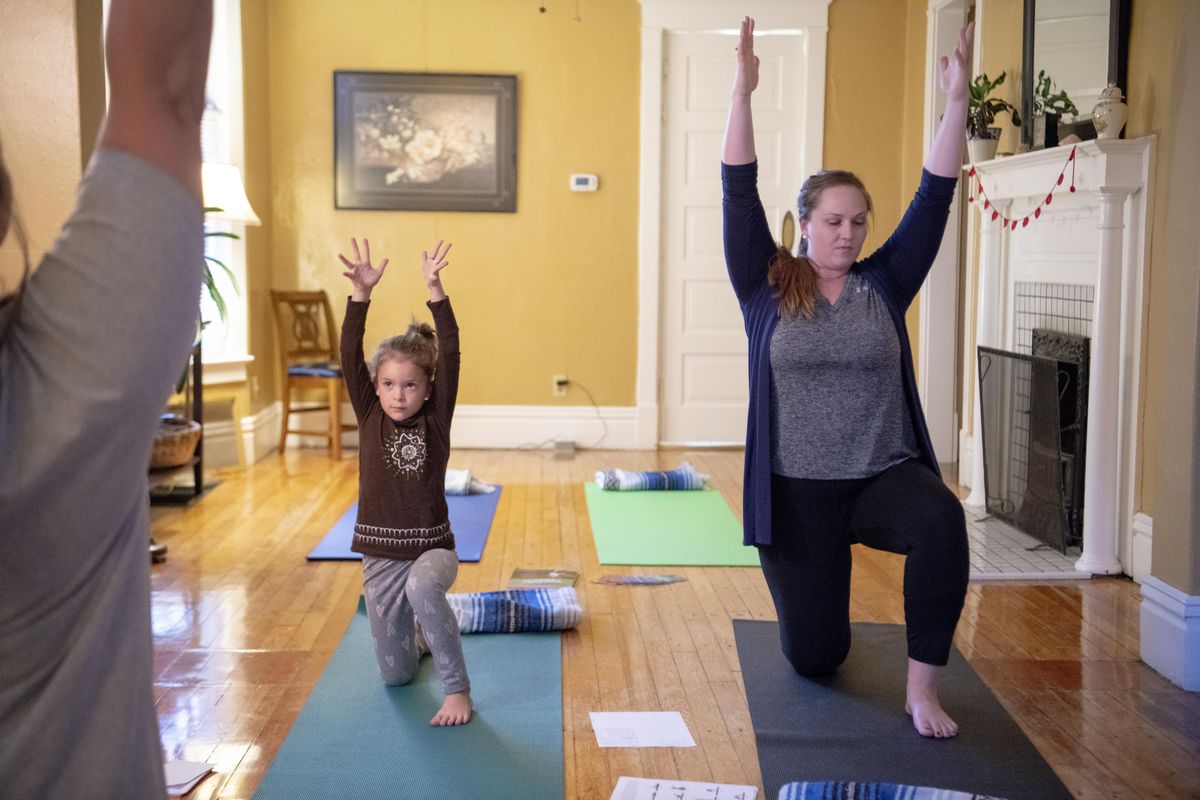Young yogis: Yoga Calm Class helps kids with exercise, mindfulness

Mindfulness, meditation and yoga are already popular among adults today, but parents are discovering more and more the benefits these can have for their children.
“Yoga Calm” is a children’s yoga and mindfulness program used in schools and community wellness centers all over the United States. It was developed to help children and adolescents learn to manage stress, difficult emotions, behavioral issues and social anxiety early on. Locally, the program is used by instructors at the Browne’s Addition Wellness Center, 2013 W. 4th Ave.
“Something about everybody doing the same things together helps the kids get grounded and become aware of how they fit in with the group,” said Naomi Leong, a mental health counselor and Yoga Calm instructor at the wellness center. “Breathing together and moving together is really important.”
The program is tailored to the needs of children and young people learning to manage social anxiety or struggling to sit still for extended periods.
“There are lots of social and emotional learning games worked into the program,” Leong said. “So it’s not just the physical yoga, it’s not just breathing exercises, it’s moving around and being active and interacting with your peers, developing a sense of community.”
Every Yoga Calm class is structured according to these five principles: community, strength, listening, grounding and stillness.
The actual class structure can vary, but the sequences usually alternate between physically focused and more calming activities.
A typical class will start with a breathing exercise. The kids take turns demonstrating proper deep breathing technique with the help of a Hoberman sphere. “They would honestly do that all day until everyone had a turn,” Leong added.
Then, once the breathing exercise has calmed everyone down from the initial excitement of starting class, an instructor will lead a “mindful moment” or short guided meditation.
“I’ll have them close their eyes if they’re comfortable with that and give them something to think about for a minute,” Leong said.
The third step usually involves a little more movement and a standing pose or two, maybe a simplified sun salutation. Following the first standing series, the instructor will lead a social-emotional game. These games focus on empathy, emotional awareness, communicating and community building.
Next, “We’ll go back into some more physical yoga … (and) I’ll bring it back down maybe with a bridge or wheel pose (and finally) relaxation pose.”
The class usually ends with a final guided meditation.
“They really like that,” Leong said. “Depending on the age that may only be a minute. Just giving them something to think about for a minute or a story or a scripted guided meditation, a poem, a progressive muscle relaxation.”
Recently the program has also been shown to have promising effects on attention and hyperactivity disorders.
“Yoga is great for lots of reasons for ADHD,” said Naomi Leong, a mental health counselor and Yoga Calm instructor at Browne’s Addition. “It helps with focus, self control, then there’s the mindfulness aspects of it. That helps strengthen the thinking part of the brain so that kids are less impulsive, more responsive, less reactive. (It) allows kids to be more in the present moment, to have a little more space to slow down and to choose their actions.”
It also helps kids with or without attention disorders to build confidence and other social strengths. Students are invited to lead their classmates. A different child is asked to demonstrate each pose.
“We try to establish that the kids are going to help lead from day one,” Leong said. “They’re very supportive of each other. After the leads are done we always do compliments. It’ll be like, ‘Wow, I really heard your voice well’ or ‘You were really brave to go first’ or ‘You remembered that really well.’”
Leong explained a tactic she’ll often use to show the kids their progress and encourage them in their efforts.
“I like to throw in crow pose every time just because it’s really challenging. It’s just a beginning arm balancing pose. We use a crash pad so they don’t hurt themselves if they fall. For some it’s easy and some are afraid to even try,” Leong said. But, “by the end of a six-week session almost all of them can do it. I like to point out like ‘think back to the first time you did that, what were you thinking?’ Most of them are like, ‘Oh, I thought I’d never be able to do it!’
“It really builds that inner confidence. You know, ‘if I think something’s hard is it really impossible?’ ”
Yoga Calm implements more than 35 years worth of research data. It is a secularized yoga program; the chanting aspect is lost and the English pose names are always used in place of their original Sanskrit counterparts.